Laughing Kookaburras
These are, without a doubt, my favourite Australian animal. No other creature is so fascinating to me- everything about them is wonderful. From their distinctive laugh to their interesting & complex social structure, to their love of play, to their funny little faces- they are the animal that made me fall in love with Australia.
Here are a few of the Kookaburras who’ve touched my life in the past few years.
(I apologize for the poor quality of the photos; I was using an old digital camera and the shots just aren't very clear. I prefer my 35mm camera and use that exclusively nowadays.)
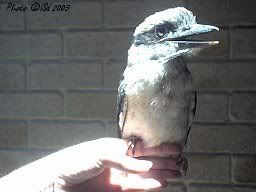
Jones in the sunshine
The bird in the picture above is Jones, (full name is “Stinky Jones”) an orphaned baby Laughing Kookaburra that I had the joy of raising. He came into care feathered, but just barely so, and I got to teach him to hunt and to fly and exposed him to my local adult Kookaburra flock who taught him to talk. When he reached release stage, he went back to the town he came from originally- we try to introduce animals precisely back to their local area, or specifically their local flock if possible. He was adopted by a family there, and is presumably having a happy, wild Kookaburra life.
People in Australia joke that baby Kookaburras- in the unfeathered stage- have a face only a mother could love. They are another of Australia’s “so ugly they’re cute” trademark babies. However, those mighty pin-feathers have a protective role- Kookaburras nests are notoriously filthy; lots of faeces and rotted ickyness from their food (they are carnivores) and maggots- the pin feathers protect the baby bird whilst they are little.
These are some of my photos of Kookaburras in my old local flock (I’ve moved form that site in the past year). They were the most delightful & friendly group of birds; they grew to trust me so much that they’d leave the fledglings in my yard while the adults went about their daytime business. They are led by Tahmee, the dominant breeding female, her husband Little Kook- (the first Kookie I became friends with, a very sociable bird) and assorted other birds including Bandit, Tippy-Grumbles, Puff, Puff Daddy and a couple of other sons & daughters who later moved on to join other neighbouring flocks or to establish their own territories.
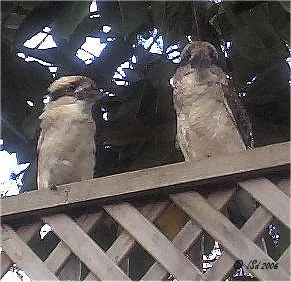
Two of Tahmee’s offspring from Spring 2005
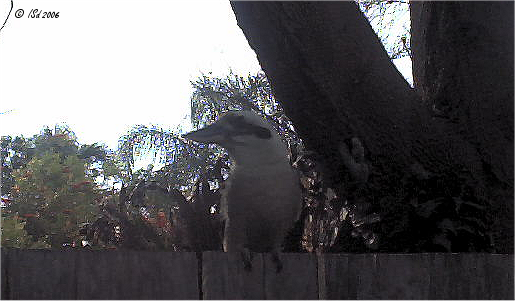
Tahmee, lead female of the flock
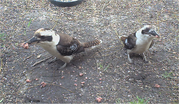
Puff Daddy and Tahmee having breakfast
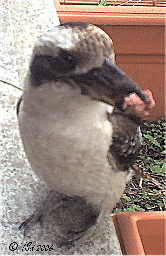
Little Kook having brekkie
Regarding the Laughing Kookaburra’s distinctive sound: Their calls are often used in movie sound effects studies to simulate generic “jungle” noises. When I first moved to Australia, I was rudely jarred awake at sunrise on one of my first mornings in country to the sound of a loud, raucous laughter coming from the roof of our flat. I sleepily woke up my husband to inform him that “there were monkeys on the roof”. He set me straight, and thus began my fascination with these wonderful birds.
Laughing Kookaburra information :
Laughing Kookaburras (Dacelo novaeguirea) are the largest member of the Kingfisher family. They are found down the eastern seaboard of Australia, from the top of Queensland, down through New South Wales, and down to the south-eastern coast of Victoria. They can also be found in coastal portions of Western Australia and South Australia. Laughing Kookaburras average in size about 46 cm (approximately 18 inches) from beak tip to tail tip. Laughing Kookaburras are a protected species in New South Wales, and may not be kept, handled or treated by unlicensed & untrained members of the public.
Their beaks are very strong and bites can cause bleeding & bruising. They are not aggressive birds, but they do have a tendency to “give eye” somewhat like a Border Collie- but in their case it is a warning sign that you are either on their “don’t mess with me” list, or else, if you are a small bird, insect or rodent, about to become dinner.
Kookaburras live in family flocks. The breeding female is dominant, and she has a male partner- they tend to mate for life, but Kookaburra “divorces” are not unknown. They breed in the spring, laying up to three or four eggs on consecutive days. The hatchlings (those who survive, there is evidence of some siblicide occurring) grow quickly, and begin to venture out of the nest at roughly six weeks of age. Often some of the older siblings remain with the parental flock and help the breeding pair to rear subsequent chicks. Flocks have their own territories, and engage in complex “laughing”, “flyover”, “wrestling” and “fly & perch” exercises to mark these territories. Because of their territoriality, it is best to keep a Kookaburra in care for as short a time as possible, and release them back into the spot where they came from.
Kookaburras are very playful- I’ve personally played tug’o war with them with sticks, chase games, and some of them loved playing in the spray from the hose when I watered the garden. They also have a game of “pick it up and put it down”- a very popular game amongst many bird species. They will eat right out of your hand, and are quite skilful at manipulating entire neighbourhoods into giving them snacks. Personally I have noticed that each bird tends to have its own very distinct personality, and each tends to have markings that make them recognisable once you get to know them. Also, if they want something, they do not hesitate to let you know- one of the local flock who’d come into care briefly decided she occasionally wanted a treat and she would pull the antenna cable down from our roof. One day she was up there pulling at it and fell off the roof, but neglected to let go of the cable on the way down. I walked out on the porch after hearing the ruckus and was confronted with the site of a Kookaburra, swinging gently by her beak at the end of a cable, stubbornly refusing to let go!
The life span of a Kookaburra is optimally twenty years or so. They have somewhat adapted to the encroachment of humans into their habitats but are protected due to their declining numbers from deforestation & pesticide use. They are the stuff of legends amongst many of the Aboriginal tribes, and have featured in songs, ad campaigns, radio shows and TV shows.
Sexing Laughing Kookaburras can be difficult. In general, males tend to develop teal-blue feathers on their wings & rear as they age, but chromosome tests reveal this happens with some females as well. Age can sometimes be determined by colouration of feathers, although this isn’t always reliable. Young birds tend to have creamy chest feathers with beige “lacy” edges, but this sometimes happens in a fresh moult as well. Usually the most reliable indicator of age is the beak: youngsters have a shorter beak that is all black; adult beaks are longer, show signs of wear, and the bottom beak turns ivory.
Good websites for more information:
* http://www.nationalparks.nsw.gov.au/npws.nsf/Content/The+laughing+kookaburra
* http://www.gould.edu.au/wildlifecams/kookaburra.asp
Brief notes on a few of the other Kookaburras I’ve cared for & successfully released: One with a white-tailed spider bite in its mouth; one who suffered an horrific car accident but survived against all odds (we named him “Lucky” as he came in on St. Patrick’s Day); and recently one with an unknown illness that was cured with antibiotics, vitamins, warmth & rest and a very lean & light diet of boiled chicken soaked with insectivore slurry. (The butcher thinks I am nuts!)
Now that spring is here, I am sure more Kookies coming to stay for a bit is right around the corner!
Copyright 2006 by Rachael M. Roth for Manifestation Publications, a division of Infinite Stars Designs (ABN #30 646 269 206 NSW Australia). All rights reserved. Do not repost or replicate this review in any form without the express written permission of the author.
Cross posted to my personal journal rachaels_lj and rehab_wildlife.

Blinkie made by brokenlette
Here are a few of the Kookaburras who’ve touched my life in the past few years.
(I apologize for the poor quality of the photos; I was using an old digital camera and the shots just aren't very clear. I prefer my 35mm camera and use that exclusively nowadays.)

Jones in the sunshine
The bird in the picture above is Jones, (full name is “Stinky Jones”) an orphaned baby Laughing Kookaburra that I had the joy of raising. He came into care feathered, but just barely so, and I got to teach him to hunt and to fly and exposed him to my local adult Kookaburra flock who taught him to talk. When he reached release stage, he went back to the town he came from originally- we try to introduce animals precisely back to their local area, or specifically their local flock if possible. He was adopted by a family there, and is presumably having a happy, wild Kookaburra life.
People in Australia joke that baby Kookaburras- in the unfeathered stage- have a face only a mother could love. They are another of Australia’s “so ugly they’re cute” trademark babies. However, those mighty pin-feathers have a protective role- Kookaburras nests are notoriously filthy; lots of faeces and rotted ickyness from their food (they are carnivores) and maggots- the pin feathers protect the baby bird whilst they are little.
These are some of my photos of Kookaburras in my old local flock (I’ve moved form that site in the past year). They were the most delightful & friendly group of birds; they grew to trust me so much that they’d leave the fledglings in my yard while the adults went about their daytime business. They are led by Tahmee, the dominant breeding female, her husband Little Kook- (the first Kookie I became friends with, a very sociable bird) and assorted other birds including Bandit, Tippy-Grumbles, Puff, Puff Daddy and a couple of other sons & daughters who later moved on to join other neighbouring flocks or to establish their own territories.

Two of Tahmee’s offspring from Spring 2005

Tahmee, lead female of the flock

Puff Daddy and Tahmee having breakfast

Little Kook having brekkie
Regarding the Laughing Kookaburra’s distinctive sound: Their calls are often used in movie sound effects studies to simulate generic “jungle” noises. When I first moved to Australia, I was rudely jarred awake at sunrise on one of my first mornings in country to the sound of a loud, raucous laughter coming from the roof of our flat. I sleepily woke up my husband to inform him that “there were monkeys on the roof”. He set me straight, and thus began my fascination with these wonderful birds.
Laughing Kookaburra information :
Laughing Kookaburras (Dacelo novaeguirea) are the largest member of the Kingfisher family. They are found down the eastern seaboard of Australia, from the top of Queensland, down through New South Wales, and down to the south-eastern coast of Victoria. They can also be found in coastal portions of Western Australia and South Australia. Laughing Kookaburras average in size about 46 cm (approximately 18 inches) from beak tip to tail tip. Laughing Kookaburras are a protected species in New South Wales, and may not be kept, handled or treated by unlicensed & untrained members of the public.
Their beaks are very strong and bites can cause bleeding & bruising. They are not aggressive birds, but they do have a tendency to “give eye” somewhat like a Border Collie- but in their case it is a warning sign that you are either on their “don’t mess with me” list, or else, if you are a small bird, insect or rodent, about to become dinner.
Kookaburras live in family flocks. The breeding female is dominant, and she has a male partner- they tend to mate for life, but Kookaburra “divorces” are not unknown. They breed in the spring, laying up to three or four eggs on consecutive days. The hatchlings (those who survive, there is evidence of some siblicide occurring) grow quickly, and begin to venture out of the nest at roughly six weeks of age. Often some of the older siblings remain with the parental flock and help the breeding pair to rear subsequent chicks. Flocks have their own territories, and engage in complex “laughing”, “flyover”, “wrestling” and “fly & perch” exercises to mark these territories. Because of their territoriality, it is best to keep a Kookaburra in care for as short a time as possible, and release them back into the spot where they came from.
Kookaburras are very playful- I’ve personally played tug’o war with them with sticks, chase games, and some of them loved playing in the spray from the hose when I watered the garden. They also have a game of “pick it up and put it down”- a very popular game amongst many bird species. They will eat right out of your hand, and are quite skilful at manipulating entire neighbourhoods into giving them snacks. Personally I have noticed that each bird tends to have its own very distinct personality, and each tends to have markings that make them recognisable once you get to know them. Also, if they want something, they do not hesitate to let you know- one of the local flock who’d come into care briefly decided she occasionally wanted a treat and she would pull the antenna cable down from our roof. One day she was up there pulling at it and fell off the roof, but neglected to let go of the cable on the way down. I walked out on the porch after hearing the ruckus and was confronted with the site of a Kookaburra, swinging gently by her beak at the end of a cable, stubbornly refusing to let go!
The life span of a Kookaburra is optimally twenty years or so. They have somewhat adapted to the encroachment of humans into their habitats but are protected due to their declining numbers from deforestation & pesticide use. They are the stuff of legends amongst many of the Aboriginal tribes, and have featured in songs, ad campaigns, radio shows and TV shows.
Sexing Laughing Kookaburras can be difficult. In general, males tend to develop teal-blue feathers on their wings & rear as they age, but chromosome tests reveal this happens with some females as well. Age can sometimes be determined by colouration of feathers, although this isn’t always reliable. Young birds tend to have creamy chest feathers with beige “lacy” edges, but this sometimes happens in a fresh moult as well. Usually the most reliable indicator of age is the beak: youngsters have a shorter beak that is all black; adult beaks are longer, show signs of wear, and the bottom beak turns ivory.
Good websites for more information:
* http://www.nationalparks.nsw.gov.au/npws.nsf/Content/The+laughing+kookaburra
* http://www.gould.edu.au/wildlifecams/kookaburra.asp
Brief notes on a few of the other Kookaburras I’ve cared for & successfully released: One with a white-tailed spider bite in its mouth; one who suffered an horrific car accident but survived against all odds (we named him “Lucky” as he came in on St. Patrick’s Day); and recently one with an unknown illness that was cured with antibiotics, vitamins, warmth & rest and a very lean & light diet of boiled chicken soaked with insectivore slurry. (The butcher thinks I am nuts!)
Now that spring is here, I am sure more Kookies coming to stay for a bit is right around the corner!
Copyright 2006 by Rachael M. Roth for Manifestation Publications, a division of Infinite Stars Designs (ABN #30 646 269 206 NSW Australia). All rights reserved. Do not repost or replicate this review in any form without the express written permission of the author.
Cross posted to my personal journal rachaels_lj and rehab_wildlife.

Blinkie made by brokenlette